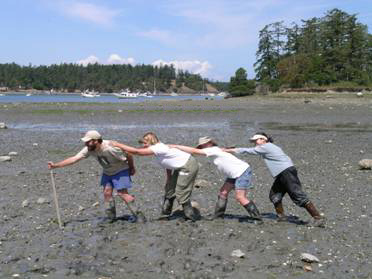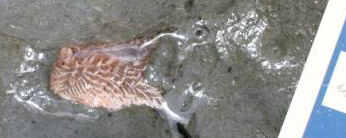
Functional Characteristics of Garrison Bay Organisms
Locomotion
Reproduction
Feeding
Protection

Many organisms at Garrison Bay live epifaunally and infaunally. The muddy substrate provides an ideal habitat for burrowing, a common lifestyle for many polycheates and bivalves. Evidence of their activity can be seen in surface trails on the loose sediment. Nemerteans, polycheates, bivalves, and gastropods are among those whose locomotion can be seen by such traces, and characteristics of the trail can even be used to deduce the organism that made it. Various types of trails seen on the mud surface result from the use of parapodia, muscular foot, cilia, undulatory and peristaltic motion, and mucous secretions.

Paranemertes moving along the sediment |
|

Nereis using parapodia for locomotion |
|

Battilaria sp. plowing through the surface sediment |
Gastropod snails such as Battilaria are often found "trail blazing" on the sediment surface. The gastropod is propelled by ciliary motion and wave action of the foot. |

Cancer magister |
|

Hermissenda crassicornis |
|

bird tracks in the mud |
|
[Return to themes] - [Garrison Bay Main Page] - [Home]
Reproduction

Evidence of reproduction at Garrison Bay is widespread. Gastropod egg masses of at least three species are found frequently throughout the mid- to low-intertidal zone. Free-spawning polychaetes are common both on the mud surface and in burrows, as evidenced by an oweniid polychaete that we observed spawning in the lab on its day of collection. Several species also brood young, including the bivalve Transenella sp. and the brittle star Amphipholis squamata. Organisms that brood may burrow in the mud or inhabit small, protected microhabitats.
Each strategy may have particular advantages in the muddy habitat. Because surface drainage is poor, the moist environment and abundance of hard substrate, in the form of shells and rocks, provide suitable conditions for the survival of egg masses. However, egg masses may be exposed to several threats at low tide, including temperature stress, desiccation, and predation. Egg masses have a large gel component that can help to protect them from desiccation, but may do little to relieve temperature stress.
External fertilization may have advantages in this environment due to the relatively calm waters and relatively dense aggregations of organisms, such as burrowing clams. Some free spawners show specialized strategies to increase the chance of fertilization. For example, polychaetes of the genus Nereis undergo a life-history transformation where the adult body transforms into a pelagic stage devoted entirely to spawning gametes.
Organisms that utilize asexual reproduction can ensure replication even in the absence of nearby mates. In some sea anemones, asexual fission or budding allows for the production of dense aggregations of genetically identical individuals, an effective strategy for colonizing small patches of hard substrate.

Egg mass of Searlesia dira 
Egg mass ribbons of Haminoea 
Globose egg mass of Melanochlamys |
The most easily observed reproductive strategy in the bay involves egg masses laid by gastropods. We found egg masses from three species: Searlesia dira, Haminoea vesicula , and Melanochlamys diomedea. The egg masses of S. dira occurred on the inside surfaces of shells near rocks in the lower intertidal zone. These egg masses are relatively small (the one pictured is about 1 cm total diameter). |
Polychaete worms exhibit a variety of reproductive strategies, including broadcast spawning, brooding, and the laying of egg capsules. Most polychaetes are dioecious, with gametes stored in the coelom, the large fluid-filled cavity within the body. External fertilization occurs by releasing gametes into the water, through ducts or by rupturing the body wall (as shown in the picture of the oweniid polychaete to the left). Nereids and syllids have developed epitoky, where a sexually reproductive worm is produced that can swim and join in swarming events, increasing the chances of successful fertilization. |

Free Spawning of an Owenidae polychaete 
Eggs in cirratulid polychaetes |

siphon of the gaper clam Tresus capex |
|
|

the sea anemone Metridium |
[Return to themes] - [Garrison Bay Main Page] - [Home]
Feeding

The soft sediment-dwellers of Garrison Bay employ a variety of feeding strategies, including deposit feeding, predation, filter/suspension feeding, and scavenging. Feeding in a muddy habitat presents a unique set of challenges, particularly to predators and filter feeders. Predators must contend with unstable surfaces that impede rapid movement and suspended particles that can conceal prey. Sediment in suspension is a significant problem for filter feeders, whose filtering mechanisms can easily become clogged, and for other suspension feeders that may be have greater difficult encountering and distinguishing food particles. On the other hand, mud is an ideal setting for deposit feeders and scavengers because it has a high organic content and, thus, provides an accessible food source.
|
|
|
Click image
to see movie of feeding terebellid
|
|
|
|
|
Shell valve of Protothaca staminea, drilled by
predatory gastropod
|
|

A large Cancer crab |

a nereid polychaete worm burrowing into the mud |
[Return to themes] - [Garrison Bay Main Page] - [Home]
Protection 
Organisms on the mud flats show different strategies for protection from both physical stresses and predation. Although rapid flight is a typical response to predators, many invertebrates lack the ability for a rapid flight response. In such cases, species have adopted a thick shell covering, camouflage, or special defensive mechanisms.
During our observations in the field, we noticed that burrows of the gaper clam Tresus capax decreased in frequency with increasing tidal height (corresponding to increased exposure time during low tide). This may have been in response to dryer conditions at the surface. The deep burrows of Tresus capax, and other bivalves, may be advantageous for protection from desiccation as well as from potential predators.

Metridium sp.
Paranemertes sp.
Hermissenda crassicornis
Special defensive mechanisms include the stinging cells or nematocysts found in anemones. These cells are used as a defensive strategy as well as in prey capture. Hermissenda crassicornis preys upon hydroids and actually incorporates the acquired nematocysts into their own integument as a defensive device. The harpoon proboscis and venomous stylet of nemerteans (e.g. , in addition to being used in prey capture, can also be used as a defensive device against soft-bodied predators.
Shell adaptations such as a thick nacreous layer, a high-spire, and shapes that facilitate suction onto a substrate are found at Garrison Bay. The thick nacreous layer improves the relative hardness of the shell by aligning the CaCO3 crystals into a cross lamellar pattern that is most resistant to crushing by predators. Increasing the hardness of the shell provides an advantage to predators such as crabs and sea gulls.
|
Lottia pelta |

Siphon of Tresus capax |
A typical response upon disturbance of the gaper clam Tresus capax, which is abundant at Garrison Bay, is to fully retract its siphon into the sediment. Burrowing deep has multiple advantages, including escape from predators and avoiding the physical stresses of the intertidal at low tide. |